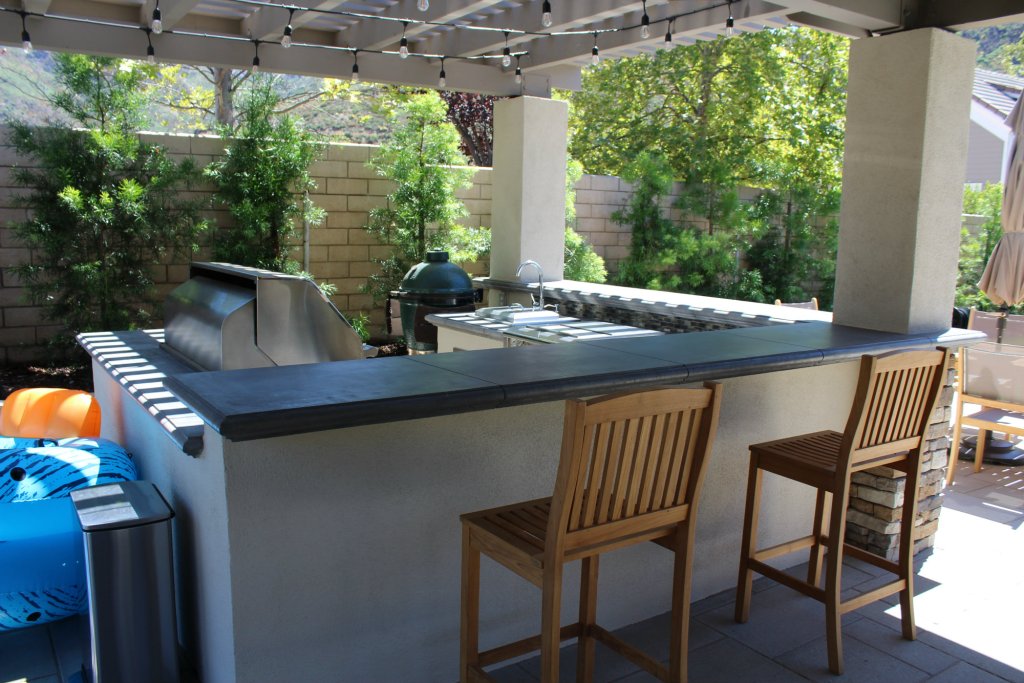There’s nothing like a covered outdoor living space to provide maximum year-round use of the backyard — whether it’s a solid roof to provide complete shade and shelter or a latticed cover for partial sunlight.
When you add fire to the mix, such as with an outdoor grill, the co-existence of flame with the roof structure must be addressed. Follow these tips to safeguard your creation and your clients:
Use sturdy material for the roof.
The bulkier the material, the longer it takes to ignite. So solid roofs will have a better chance of surviving exposure to direct flame.
The same rule applies to open roofs. For that reason, Scott Cohen uses nothing smaller than 4-by-4’s on his latticework roofs, which generally provide a 50/50 ration of shade to sun.
“You can imagine that a lightweight piece of lattice screen — maybe even 2-by-4’s, 2-by-2’s or 1-by-1’s — would go up pretty easily,” says the president and garden artisan at The Green Scene Landscaping & Pools in the Los Angeles area. “You get into larger lumber size, and it reduces the risk.”
Provide surface protection.
In Cohen’s area, more inspectors are now requiring vented hoods for grills placed under solid roof structures. In addition to the venting, this also helps channel the rising smoke, heat and grease away from the roof surface.
On both solid and openwork roofs, these officials often require fireproof paint directly above the grill or fire feature. The material doesn’t just go on the underside of the beams, but all the way around.
If a grill is set against a wall, Paolo Benedetti also prefers to use impervious materials on that surface as well, so grease can’t penetrate. This serves as fire protection, preventing a grease-soaked surface that is easier to ignite. This measure also makes future resurfacing more convenient.
This issue presented itself to Benedetti, principal and designer of Aquatic Technology Pool & Spa in Morgan Hill, Calif., on a recent renovation job. After crews pulled a barbecue back from a wall, you could see an outline of grease going up about 12 feet. This caused an adhesion problem for the next coat of plaster.
“The stucco guys couldn’t get a new coat of plaster to bond to the old stucco because all the grease had just embedded itself into the wall, Benedetti says. “They tried pressure washing, they tried sand blasting, but the grease had embedded itself.”
He likes to use sheet metal, tile, or another surface that is impervious and easy to clean.
Consider placing the grill outside.
Builders who don’t want to deal with things like flame-retardant materials or venting can place the grill a couple feet outside the footprint of the roof.
“There’s no reason the footprint of your island couldn’t extend slightly beyond the thatched roof,” Benedetti says. “Flames go pretty vertical, so if there’s a flare-up, it’s going up but it’s not coming into contact with the roof.”
It’s true that the grillmaster will lose some of the benefits of the shade. “But you can step up just long enough to flip the burgers, and then step back underneath,” Benedetti says.
Be aware in fire hazard areas.
Some codes in Cohen’s area are meant to doubly protect structures in areas that are susceptible to wild fires.
Some of these municipalities require builders to use a layered approach to solid roofs — starting with tongue-and-groove lumber on the underside, which is visible in the patio, then ¾- to 1-inch drywall above that, then plywood, 40-lb. roofing paper and, finally, solid clay tiles. In these cases, Cohen uses 2-by-6 lumber.
Examine and question manufacturer instructions.
An increasing number of pre-manufactured fire features are hitting the market, and some builders are taking advantage of them to dress up a covered patio or pool.
When doing this, do not only consult the owners’ manual for installation instructions, but also verify that the product is even safe for the application.
“Many of the fire features that people in the outdoor industry put under rooflines are not designed for that,” Benedetti says. “They’re designed to be sitting freestanding out in the yard and direct-venting into the atmosphere. A lot of manufacturers’ cut sheets don’t even address putting them under a roofline or a building.”
If the instructions do not explain how to safely install the product under a roof — with stipulations such as clearances and venting requirements — then verify with the manufacturer that the product is appropriate under a roof.
